Using Pleiades Satellite Imagery to Monitor Multi-Annual Coastal Dune Morphological Changes
Abstract
:1. Introduction
2. Materials and Methods
2.1. Study Sites
2.2. Datasets and Methods
2.2.1. Pleiades Images
2.2.2. Ames Stereo Pipeline (ASP)
2.2.3. Ground Control Points (GCPs) for Pleiades DEMs Altimetry Correction
2.2.4. Large Airborne LiDAR Data for Pleiades DEMs Validation
3. Results
3.1. Comparison Between Pleiades and LiDAR DEMs
3.2. Satellite-Derived Coastal Dune Morphological Change
3.2.1. Large-Scale Patterns of Coastal Dune Changes
3.2.2. Coastal Dune Blowout Dynamics
4. Discussion
4.1. Performance and Sources of Errors
4.2. Future Perspectives
5. Conclusions
Author Contributions
Funding
Data Availability Statement
Acknowledgments
Conflicts of Interest
Abbreviations
| ASP | Ames Stereo Pipeline |
| CNES | Centre National d’Etudes Spatiales |
| DEM | Digital Elevation Model |
| DINAMIS | Dispositif Institutionnel National d’Approvisionnement Mutualisé en Imagerie |
| GCP | Ground Control Point |
| GNSS | Global Navigation Satellite System |
| LiDAR | Light Detection And Ranging |
| NW | Northwest |
| RMSE | Root Mean Square Errors |
| SW | Southwest |
| UAV | Unmanned Aerial Vehicle |
| W | West |
References
- Hesp, P. Foredunes and blowouts: Initiation, geomorphology and dynamics. Geomorphology 2002, 48, 245–268. [Google Scholar] [CrossRef]
- Ruessink, B.G.; Jeuken, M.C.J.L. Dunefoot dynamics along the Dutch coast. Earth Surf. Process. Landf. 2002, 27, 1043–1056. [Google Scholar] [CrossRef]
- Delgado-Fernandez, I.; Davidson-Arnott, R. Meso-scale aeolian sediment input to coastal dunes: The nature of aeolian transport events. Geomorphology 2011, 126, 217–232. [Google Scholar] [CrossRef]
- De Vries, S.; Southgate, H.N.; Kanning, W.; Ranasinghe, R. Dune behavior and aeolian transport on decadal timescales. Coast. Eng. 2012, 67, 41–53. [Google Scholar] [CrossRef]
- Bauer, B.O.; Hesp, P.A.; Smyth, T.A.G.; Walker, I.J.; Davidson-Arnott, R.G.D.; Pickart, A.; Grilliot, M.; Rader, A. Air flow and sediment transport dynamics on a foredune with contrasting vegetation cover. Earth Surf. Process. Landf. 2022, 47, 2811–2829. [Google Scholar] [CrossRef]
- Fernández-Montblanc, T.; Duo, E.; Ciavola, P. Dune reconstruction and revegetation as a potential measure to decrease coastal erosion and flooding under extreme storm conditions. Ocean. Coast. Manag. 2020, 188, 105075. [Google Scholar] [CrossRef]
- Burvingt, O.; Castelle, B. Storm response and multi-annual recovery of eight coastal dunes spread along the Atlantic coast of Europe. Geomorphology 2023, 435, 108735. [Google Scholar] [CrossRef]
- Castelle, B.; Marieu, V.; Bujan, S.; Splinter, K.D.; Robinet, A.; Sénéchal, N.; Ferreira, S. Impact of the winter 2013–2014 series of severe Western Europe storms on a double barred sandy coast: Beach and dune erosion and megacusp embayments. Geomorphology 2015, 238, 135–148. [Google Scholar] [CrossRef]
- Walker, I.J.; Davidson-Arnott, R.G.D.; Bauer, B.O.; Hesp, P.A.; Delgado-Fernandez, I.; Ollerhead, J.; Smyth, T.A.G. Scale-dependent perspectives on the geomorphology and evolution of beach-dune systems. Earth-Sci. Rev. 2017, 171, 220–253. [Google Scholar] [CrossRef]
- Hunter, R.E.; Richmond, B.M. Daily cycles in coastal dunes. Sediment. Geol. 1988, 55, 43–67. [Google Scholar] [CrossRef]
- Laporte-Fauret, Q.; Castelle, B.; Marieu, V.; Nicolae-Lerma, A.; Rosebery, D. Foredune blowout formation and subsequent evolution along a chronically eroding high-energy coast. Geomorphology 2022, 414, 108398. [Google Scholar] [CrossRef]
- Robin, N.; Billy, J.; Nicolae Lerma, A.; Castelle, B.; Hesp, P.A. Natural remobilization and historical evolution of a modern coastal transgressive dunefield. Earth Surf. Process. Landf. 2023, 48, 1064–1083. [Google Scholar] [CrossRef]
- Nicolae Lerma, A.; Ayache, B.; Ulvoas, B.; Paris, F.; Bernon, N.; Bulteau, T.; Mallet, C. Pluriannual beach-dune evolutions at regional scale: Erosion and recovery sequences analysis along the Aquitaine coast based on airborne LiDAR data. Cont. Shelf Res. 2019, 189, 10397. [Google Scholar] [CrossRef]
- Harley, M.; Turner, I.; Short, A.; Ranasinghe, R. A re-evaluation of coastal embayment rotation: The dominance of cross-shore versus alongshore sediment transport processes, Collaroy-Narrabeen Beach, SE Australia. J. Geophys. Res. Earth 2011, 116, F04033. [Google Scholar]
- Burvingt, O.; Masselink, G.; Scott, T.; Davidson, M.; Russell, P. Climate forcing of regionally-coherent extreme storm impact and recovery on embayed beaches. Mar. Geol. 2018, 401, 112–128. [Google Scholar] [CrossRef]
- Mancini, F.; Dubbini, M.; Gattelli, M.; Stecchi, F.; Fabbri, S.; Gabbianelli, G. Using unmanned aerial vehicles (UAV) for high-resolution reconstruction of topography: The structure from motion approach on coastal environments. Remote Sens. 2013, 5, 6880–6898. [Google Scholar] [CrossRef]
- Turner, I.L.; Harley, M.D.; Drummond, C.D. UAVs for coastal surveying. Coast. Eng. 2016, 114, 19–24. [Google Scholar] [CrossRef]
- Guisado-Pintado, E.; Jackson, D.W.T.; Rogers, D. 3D mapping efficacy of a drone and terrestrial laser scanner over a temperate beach-dune zone. Geomorphology 2019, 328, 157–172. [Google Scholar] [CrossRef]
- Laporte-Fauret, Q.; Marieu, V.; Castelle, B.; Michalet, R.; Bujan, S.; Rosebery, D. Low-Cost UAV for High-Resolution and Large-Scale Coastal Dune Change Monitoring Using Photogrammetry. J. Mar. Sci. Eng. 2019, 7, 63. [Google Scholar] [CrossRef]
- Burvingt, O.; Masselink, G.; Russell, P.; Scott, T. Classification of beach response to extreme storms. Geomorphology 2017, 295, 722–737. [Google Scholar] [CrossRef]
- Konstantinou, A.; Stokes, C.; Masselink, G.; Scott, T. The extreme 2013/14 winter storms: Regional patterns in multi-annual beach recovery. Geomorphology 2021, 389, 107828. [Google Scholar] [CrossRef]
- Vos, K.; Harley, M.D.; Splinter, K.D.; Simmons, J.A.; Turner, I.L. Sub-annual to multi-decadal shoreline variability from publicly available satellite imagery. Coast. Eng. 2019, 150, 160–174. [Google Scholar] [CrossRef]
- Bergsma, E.W.J.; Almar, R.; Rolland, A.; Binet, R.; Brodie, K.L.; Bak, A.S. Coastal morphology from space: A showcase of monitoring the topography-bathymetry continuum. Remote Sens. Environ. 2021, 261, 112469. [Google Scholar] [CrossRef]
- Vitousek, S.; Buscombe, D.; Vos, K.; Barnard, P.L.; Ritchie, A.C.; Warrick, J.A. The future of coastal monitoring through satellite remote sensing. Coast. Futures 2023, 1, e10. [Google Scholar] [CrossRef]
- Shean, D.E.; Alexandrov, O.; Moratto, Z.M.; Smith, B.E.; Joughin, I.R.; Porter, C.; Morin, P. An automated, open-source pipeline for mass production of digital elevation models (DEMs) from very-high-resolution commercial stereo satellite imagery. J. Photogramm. Remote Sens. 2016, 116, 101–117. [Google Scholar] [CrossRef]
- Beyer, R.A.; Alexandrov, O.; McMichael, S. The Ames Stereo Pipeline: NASA’s Open Source Software for Deriving and Processing Terrain Data. Earth Space Sci. 2018, 5, 537–548. [Google Scholar] [CrossRef]
- Rupnik, E.; Daakir, M.; Pierrot Deseilligny, M. Micmac—A free, open-source solution for photogrammetry. Open Geospat. Data Softw. Stand. 2017, 2, 14. [Google Scholar] [CrossRef]
- Michel, J.; Sarrazin, E.; Youssefi, D.; Cournet, M.; Buffe, F.; Delvit, J.M.; Emilien, A.; Bosman, J.; Melet, O.; L’Helguen, C. A new satellite imagery stereo pipeline designed for scalability, robustness and performance. ISPRS Ann. Photogramm. Remote Sens. Spat. Inf. Sci. 2020, V-2-2020, 171–178. [Google Scholar] [CrossRef]
- Berthier, E.; Vincent, C.; Magnússon, E.; Gunnlaugsson, A.; Pitte, P.; Le Meur, E.; Masiokas, M.; Ruiz, L.; Pálsson, F.; Belart, J.M.C.; et al. Glacier topography and elevation changes derived from Pléiades sub-meter stereo images. Cryospher 2014, 8, 2275–2291. [Google Scholar] [CrossRef]
- Melis, M.T.; Pisani, L.; De Waele, J. On the Use of Tri-Stereo Pleiades Images for the Morphometric Measurement of Dolines in the Basaltic Plateau of Azrou (Middle Atlas, Morocco). Remote Sens. 2021, 13, 4087. [Google Scholar] [CrossRef]
- Bagnardi, M.; Pablo, J.G.; Hooper, A. High-Resolution Digital Elevation Model from Tri-Stereo Pleiades-1 Satellite Imagery for Lava Flow Volume Estimates at Fogo Volcano. Geophys. Res. Lett. 2016, 43, 6267–6275. [Google Scholar] [CrossRef]
- Palaseanu-Lovejoy, M.; Bisson, M.; Spinetti, C.; Buongiorno, M.F.; Alexandrov, O.; Cecere, T. High-Resolution and Accurate Topography Reconstruction of Mount Etna from Pleiades Satellite Data. Remote Sens. 2019, 11, 2983. [Google Scholar] [CrossRef]
- Panagiotakis, E.; Chrysoulakis, N.; Charalampopoulou, V.; Poursanidis, D. Validation of Pleiades Tri-Stereo DSM in Urban Areas. Int. J. Geo-Inf. 2018, 7, 118. [Google Scholar] [CrossRef]
- Collin, A.; Hench, J.L.; Pastol, Y.; Planes, S.; Thiault, L.; Schmitt, R.J.; Holbrook, S.J.; Davies, N.; Troyer, M. High resolution topobathymetry using a Pleiades-1 triplet: Moorea Island in 3D. Remote Sens. Environ. 2018, 208, 109–119. [Google Scholar] [CrossRef]
- Almar, R.; Bergsma, E.W.J.; Maisongrande, P.; De Almeida, L.P.M. Wave-derived coastal bathymetry from satellite video imagery: A showcase with Pleiades persistent mode. Remote Sens. Environ. 2019, 231, 111263. [Google Scholar] [CrossRef]
- Cahalane, C.; Magee, A.; Monteys, X.; Casal, G.; Hanafin, J.; Harris, P. A comparison of Landsat 8, RapidEye and Pleiades products for improving empirical predictions of satellite-derived bathymetry. Remote Sens. Environ. 2019, 233, 111414. [Google Scholar] [CrossRef]
- Le Quilleuc, A.; Collin, A.; Jasinski, M.F.; Devillers, R. Very High-Resolution Satellite-Derived Bathymetry and Habitat Mapping Using Pleiades-1 and ICESat-2. Remote Sens. 2022, 14, 133. [Google Scholar] [CrossRef]
- James, D.; Collin, A.; Mury, A.; Qin, R. Satellite–Derived Topography and Morphometry for VHR Coastal Habitat Mapping: The Pleiades–1 Tri–Stereo Enhancement. Remote Sens. 2022, 14, 219. [Google Scholar] [CrossRef]
- Davies, B.F.R.; Gernez, P.; Geraud, A.; Oiry, S.; Rosa, P.; Zoffoli, M.L.; Barillé, L. Multi- and hyperspectral classification of soft-bottom intertidal vegetation using a spectral library for coastal biodiversity remote sensing. Remote Sens. Environ. 2023, 290, 113554. [Google Scholar] [CrossRef]
- Letortu, P.; Jaud, M.; Taouki, M.; Costa, S.; Maquaire, O.; Delacourt, C. Three-dimensional (3D) reconstructions of the coastal cliff face in Normandy (France) based on oblique Pléiades imagery: Assessment of Ames Stereo Pipeline® (ASP®) and MicMac® processing chains. Int. J. Remote Sens. 2021, 42, 4558–4578. [Google Scholar] [CrossRef]
- Almeida, L.P.; Almar, R.; Bergsma, E.W.J.; Berthier, E.; Baptista, P.; Garel, E.; Dada, O.A.; Alves, B. Deriving High Spatial-Resolution Coastal Topography From Sub-Meter Satellite Stereo Imagery. Remote Sens. 2019, 11, 590. [Google Scholar] [CrossRef]
- Taveneau, A.; Almar, R.; Bergsma, E.W.J.; Sy, B.A.; Ndour, A.; Sadio, M.; Garlan, T. Observing and Predicting Coastal Erosion at the Langue de Barbarie Sand Spit around Saint Louis (Senegal, West Africa) through Satellite-Derived Digital Elevation Model and Shoreline. Remote Sens. 2021, 13, 2454. [Google Scholar] [CrossRef]
- Butel, R.; Dupuis, H.; Bonneton, P. Spatial variability of wave conditions on the French Atlantic coast using in-situ data. J. Coast. Res. 2022, 36, 96–108. [Google Scholar] [CrossRef]
- Castelle, B.; Bujan, S.; Ferreira, S.; Dodet, G. Foredune morphological changes and beach recovery from the extreme 2013/2014 winter at a high-energy sandy coast. Mar. Geol. 2017, 385, 41–55. [Google Scholar] [CrossRef]
- Idier, D.; Charles, E.; Mallet, C.; Castelle, B. Longshore sediment flux hindcast and potential impact of future wave climate change along the Gironde/Landes Coast, SW France. J. Coast. Res. 2013, 65, 1785–1790. [Google Scholar] [CrossRef]
- Castelle, B.; Bujan, S.; Marieu, V.; Ferreira, S. 16 years of topographic surveys of rip-channelled high-energy meso-macrotidal sandy beach. Sci. Data 2020, 7, 410. [Google Scholar] [CrossRef] [PubMed]
- Bossard, V.; Nicolae Lerma, A. Geomorphologic characteristics and evolution of managed dunes on the South West Coast of France. Geomorphology 2020, 367, 107312. [Google Scholar] [CrossRef]
- Robin, N.; Billy, J.; Castelle, B.; Hesp, P.; Nicolae Lerma, A.; Laporte-Fauret, Q.; Marieu, V.; Rosebery, D.; Bujan, S.; Destribats, B.; et al. 150 years of foredune initiation and evolution driven by human and natural processes. Geomorphology 2021, 374, 107516. [Google Scholar] [CrossRef]
- Laporte-Fauret, Q.; Lubac, B.; Castelle, B.; Michalet, R.; Marieu, V.; Bombrun, L.; Launeau, P.; Giraud, M.; Normandin, C.; Rosebery, D. Classification of Atlantic coastal sand dune vegetation using in situ, UAV, and airborne hyperspectral data. Remote Sens. 2020, 12, 2222. [Google Scholar] [CrossRef]
- Castelle, B.; Guillot, B.; Marieu, V.; Chaumillon, E.; Hanquiez, V.; Bujan, S.; Poppeschi, C. Spatial and temporal patterns of shoreline change of a 280-km high-energy disrupted sandy coast from 1950 to 2014: SW France. Estuar. Coast. Shelf Sci. 2018, 200, 212–223. [Google Scholar] [CrossRef]
- Nicolae Lerma, A.; Castelle, B.; Marieu, V.; Robinet, A.; Bulteau, T.; Bernon, N.; Mallet, C. Decadal beach-dune profile monitoring along a 230-km high energy sandy coast: Aquitaine, southwest France. Appl. Geogr. 2022, 139, 102645. [Google Scholar] [CrossRef]
- Facciolo, G.; De Franchis, C.; Meinhardt, E. MGM: A significantly more global matching for stereovision. In Proceedings of the British Machine Vision Conference, Swansea, UK, 7–10 September 2015. [Google Scholar]
- Zabih, R.; Woodfill, J. Non-parametric local transforms for computing visual correspondence. Eur. Conf. Comput. Vis. 1994, 801, 151–158. [Google Scholar]
- Bertsimas, D.; Tsitsiklis, J. Simulated annealing. Stat. Sci. 1993, 8, 10–15. [Google Scholar] [CrossRef]
- D’Anna, M.; Idier, D.; Castelle, B.; Cozannet, G.L.; Rohmer, J.; Robinet, A. Impact of model free parameters and sea-level rise uncertainties on 20-years shoreline hindcast: The case of Truc Vert beach (SW France). Earth Surf. Process. Landf. 2020, 45, 1895–1907. [Google Scholar] [CrossRef]
- Labarthe, C.; Castelle, B.; Marieu, V.; Garlan, T.; Bujan, S. Observation and modeling of the equilibrium slope response of a high-energy meso-macrotidal sandy beach. J. Mar. Sci. Eng. 2023, 11, 584. [Google Scholar] [CrossRef]
- Azorakos, G.; Castelle, B.; Marieu, V.; Idier, D. Satellite-derived equilibrium shoreline modelling at a high-energy meso-macrotidal beach. Coast. Eng. 2024, 191, 104536. [Google Scholar] [CrossRef]
- Frank, A.J.; Kocurek, G. Airflow up the stoss slope of sand dunes: Limitations of current understanding. Geomorphology 1996, 17, 47–54. [Google Scholar] [CrossRef]
- Vanhellemont, Q.; Ruddick, K. Atmospheric correction of metre-scale optical satellite data for inland and coastal water applications. Remote Sens. Environ. 2018, 216, 586–597. [Google Scholar] [CrossRef]
- Wiggins, M.; Scott, T.; Masselink, G.; Russell, P.; McCarroll, R.J. Coastal embayment rotation: Response to extreme events and climate control, using full embayment surveys. Geomorphology 2019, 327, 385–403. [Google Scholar] [CrossRef]
- Pellerin, X.; Levoy, F.; Robin, N.; Anthony, E.J. Formation and morphodynamics of complex multi-hooked spits and the contribution of swash bars. Earth Surf. Process. Landf. 2022, 47, 159–178. [Google Scholar] [CrossRef]
- Giles, P.T. Remote sensing and cast shadows in mountainous terrain. Photogramm. Eng. Remote Sens. 2001, 67, 833–839. [Google Scholar]
- Cantrell, S.J.; Sampath, A.; Vrabel, J.C.; Bresnahan, P.; Anderson, C.; Kim, M.; Park, S. System characterization report on the Pléiades Neo Imager. In System Characterization of Earth Observation Sensors; U.S. Geological Survey Open-File Report: Reston, VA, USA, 2023. [Google Scholar]
- Durán, O.; Herrmann, H.J. Vegetation against dune mobility. Phys. Rev. Lett. 2006, 97, 188001. [Google Scholar] [CrossRef] [PubMed]
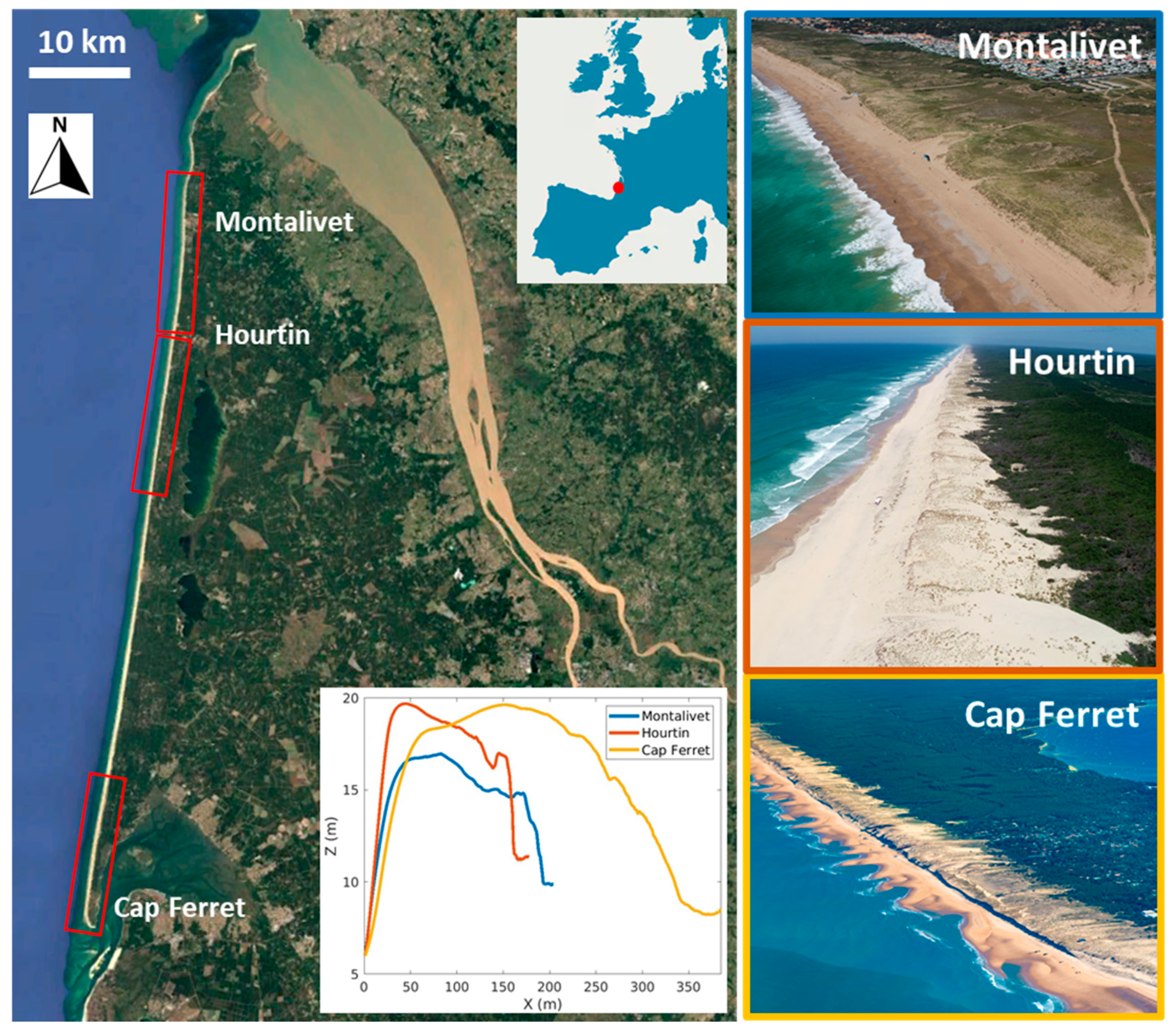
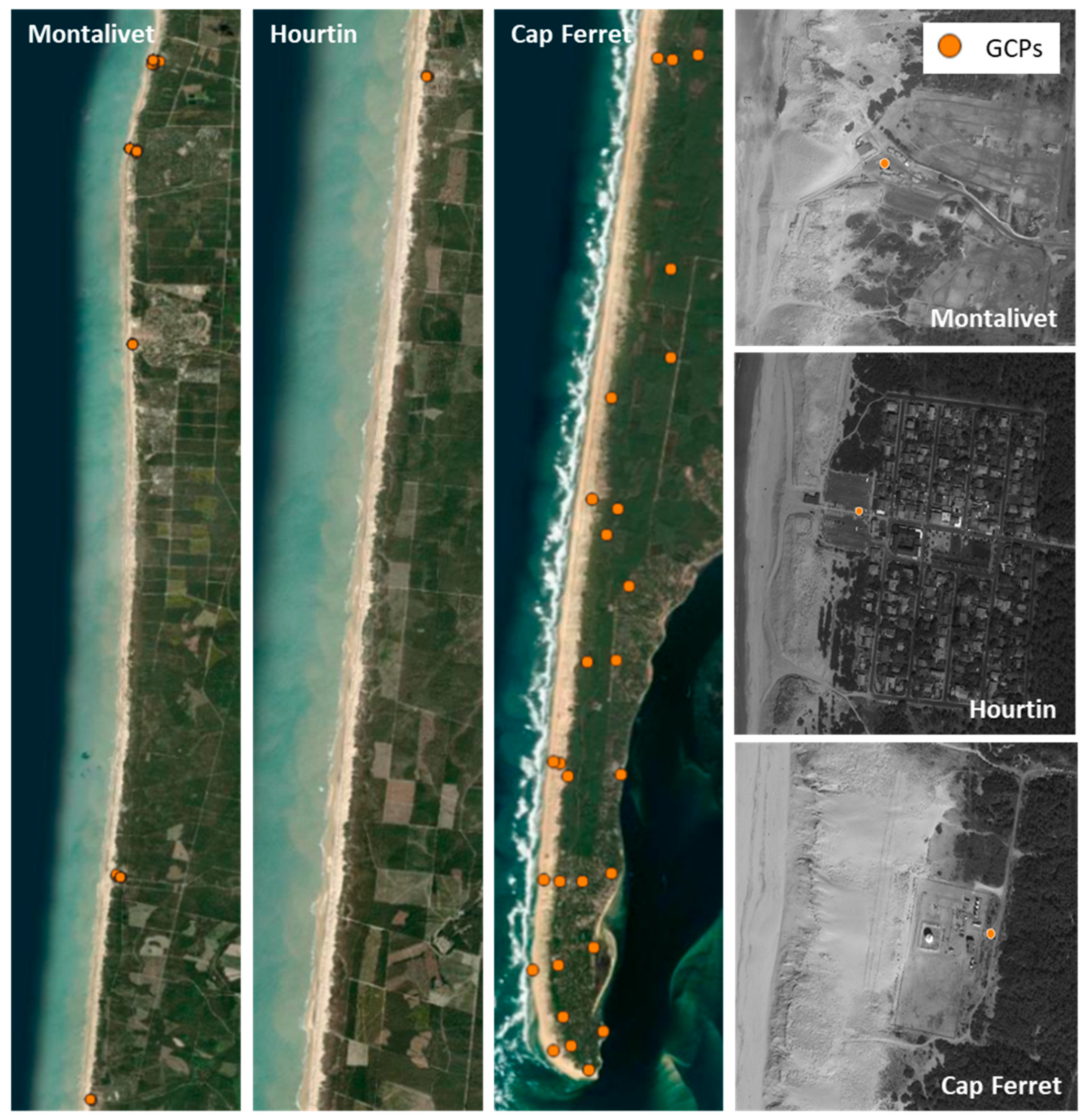

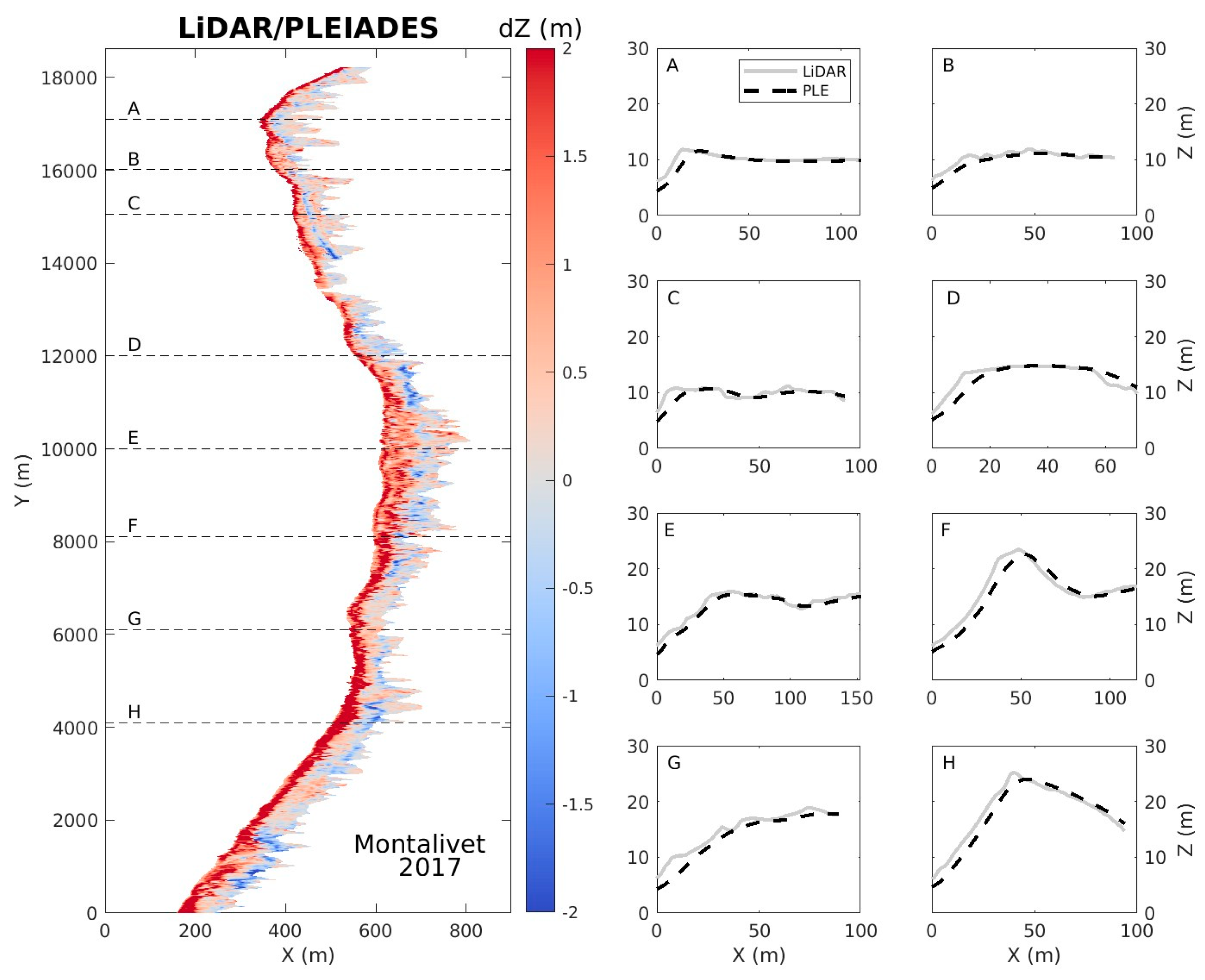
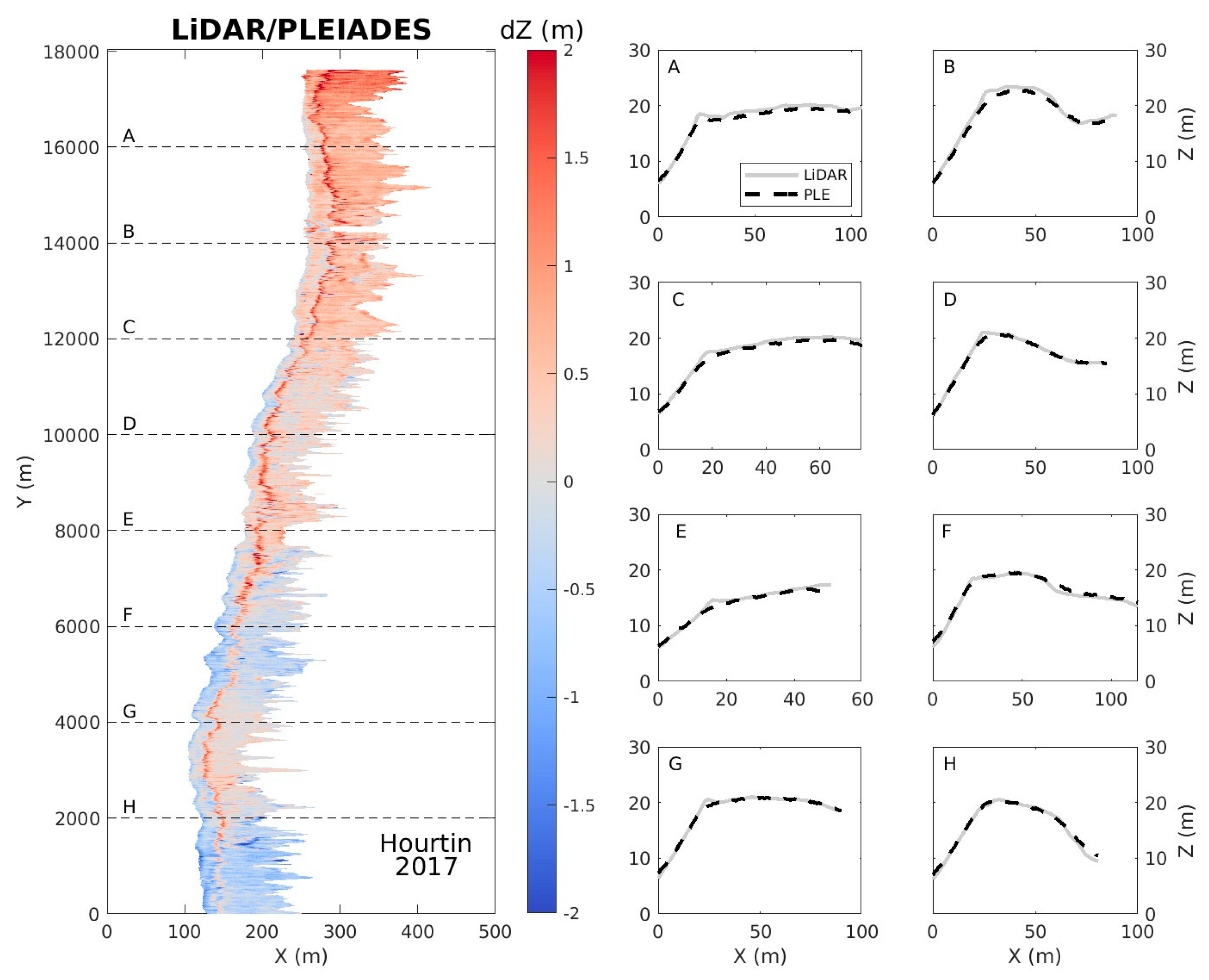

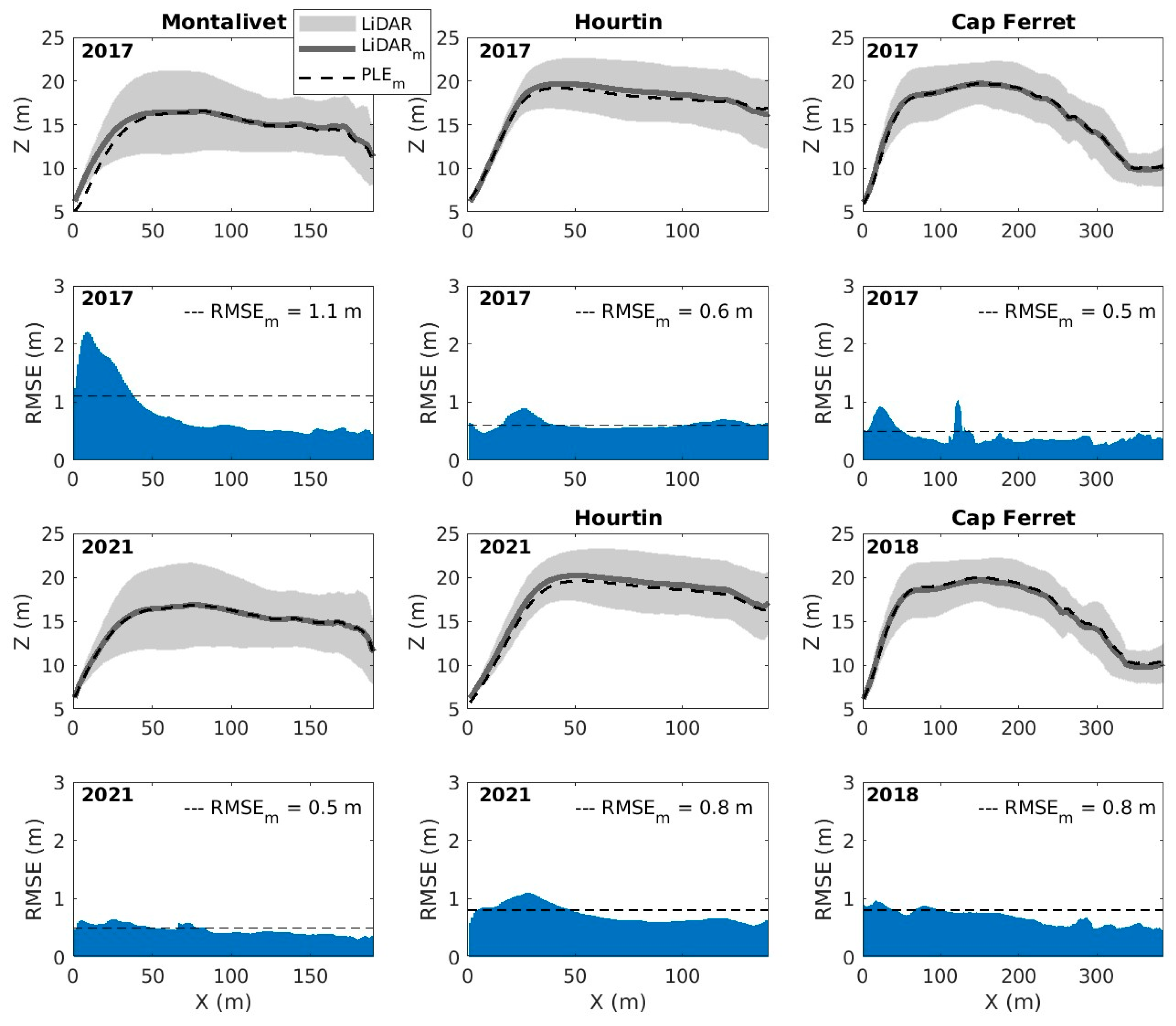

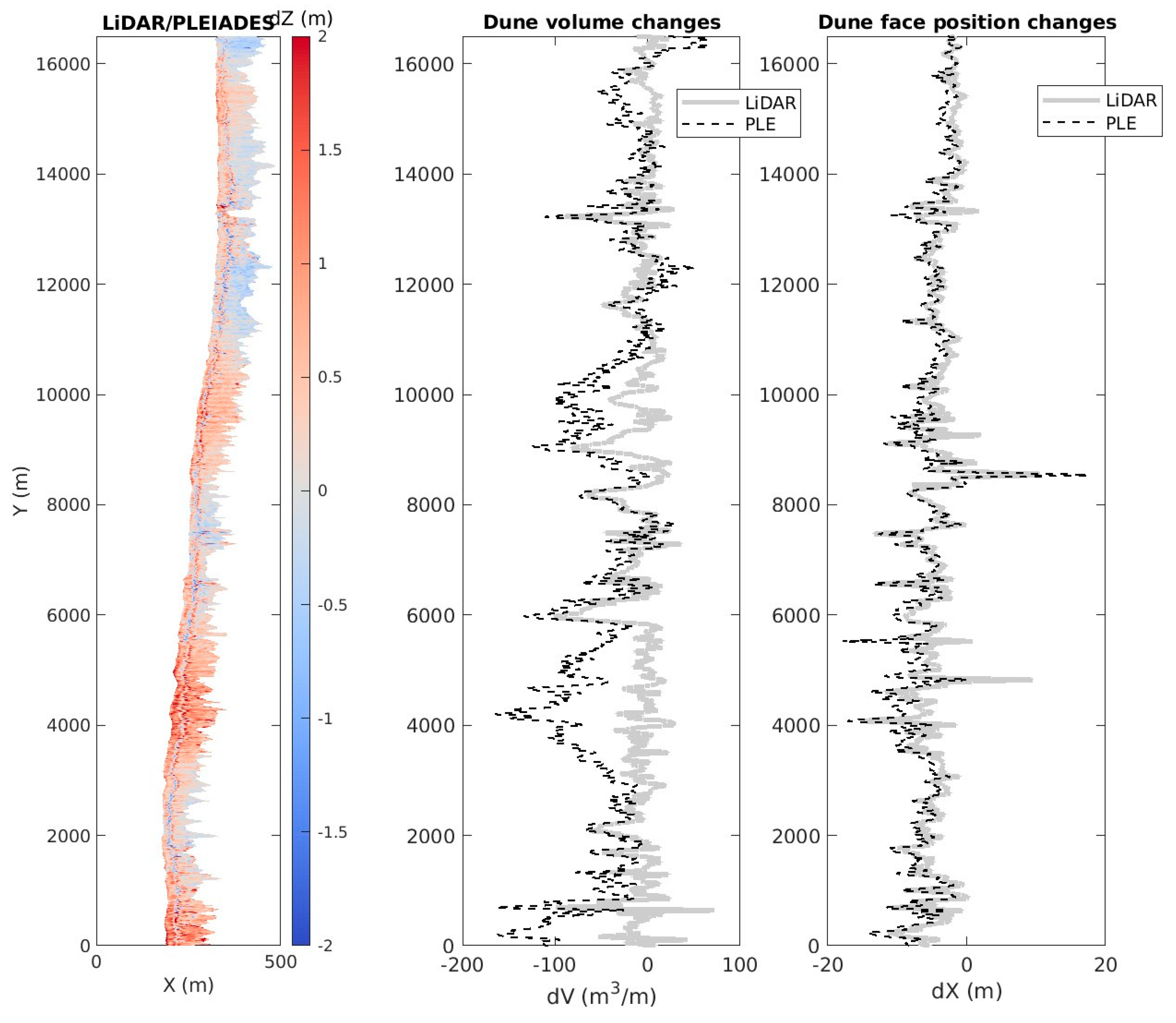

| Montalivet | ||||||
| Acquisition time (CET) | 14 April 2017 11:11:14 | 14 April 2017 11:11:27 | 14 April 2017 11:11:41 | 15 April 2017 11:14:50 | 15 April 2017 11:15:04 | 15 April 2017 11:15:18 |
| Platform | PHR1B | PHR1B | PHR1B | PHR1A | PHR1A | PHR1A |
| Viewing angles | 7.7° | 0.2° | −7.5° | 7.5° | −0.02° | −7.5° |
| Hourtin | ||||||
| Acquisition time (CET) | 4 May 2017 11:07:36 | 4 May 2017 11:07:45 | 4 May 2017 11:07:55 | 22 April 2017 11:11:16 | 22 April 2017 11:11:26 | 22 April 2017 11:11:35 |
| Platform | PHR1A | PHR1A | PHR1A | PHR1A | PHR1A | PHR1A |
| Viewing angles | 3.3° | −2.0° | −7.3° | 5.5° | 0.1° | −5.2° |
| Cap Ferret | ||||||
| Acquisition time (CET) | 8 April 2017 11:07:27 | 8 April 2017 11:07:40 | 8 April 2017 11:07:53 | 21 August 2018 11:11:56 | 21 August 2018 11:12:05 | 21 August 2018 11:12:15 |
| Platform | PHR1A | PHR1A | PHR1A | PHR1B | PHR1B | PHR1B |
| Viewing angles | 7.0° | −0.2° | −7.5° | 7.3° | 1.9° | −3.3° |
| Montalivet | ||
| Acquisition time | 14 April 2017 | 15 April 2021 |
| Number of GCPs | 63 | 63 |
| Zcorr | −55.0 m | −46.5 m |
| Hourtin | ||
| Acquisition time | 4 May 2017 | 22 April 2021 |
| Number of GCPs | 5 | 5 |
| Zcorr | −47.0 m | −44.9 m |
| Cap Ferret | ||
| Acquisition time | 8 April 2017 | 21 August 2018 |
| Number of GCPs | 24 | 24 |
| Zcorr | −45.9 m | −43.9 m |
| Montalivet | ||
| Acquisition date Pleiades images | 14 April 2017 | 15 April 2021 |
| Acquisition date LiDAR data | 4 October 2017 | 7 October 2021 |
| R | 0.98 | 0.99 |
| Averaged RMSE | 1.12 m | 0.53 m |
| Averaged Bias | −0.58 m | −0.07 m |
| Hourtin | ||
| Acquisition date Pleiades Images | 4 May 2017 | 22 April 2021 |
| Acquisition date LiDAR data | 4 October 2017 | 7 October 2021 |
| R | 0.99 | 0.99 |
| Averaged RMSE | 0.63 m | 0.80 m |
| Averaged Bias | −0.21 m | −0.59 m |
| Cap Ferret | ||
| Acquisition date Pleiades images | 8 April 2017 | 21 August 2018 |
| Acquisition date LiDAR data | 5 October 2017 | 23 October 2018 |
| R | 0.99 | 0.99 |
| Averaged RMSE | 0.51 m | 0.78 m |
| Averaged Bias | −0.12 m | 0.15 m |
Disclaimer/Publisher’s Note: The statements, opinions and data contained in all publications are solely those of the individual author(s) and contributor(s) and not of MDPI and/or the editor(s). MDPI and/or the editor(s) disclaim responsibility for any injury to people or property resulting from any ideas, methods, instructions or products referred to in the content. |
© 2025 by the authors. Licensee MDPI, Basel, Switzerland. This article is an open access article distributed under the terms and conditions of the Creative Commons Attribution (CC BY) license (https://creativecommons.org/licenses/by/4.0/).
Share and Cite
Burvingt, O.; Castelle, B.; Marieu, V.; Lubac, B.; Nicolae Lerma, A.; Robin, N. Using Pleiades Satellite Imagery to Monitor Multi-Annual Coastal Dune Morphological Changes. Remote Sens. 2025, 17, 1522. https://doi.org/10.3390/rs17091522
Burvingt O, Castelle B, Marieu V, Lubac B, Nicolae Lerma A, Robin N. Using Pleiades Satellite Imagery to Monitor Multi-Annual Coastal Dune Morphological Changes. Remote Sensing. 2025; 17(9):1522. https://doi.org/10.3390/rs17091522
Chicago/Turabian StyleBurvingt, Olivier, Bruno Castelle, Vincent Marieu, Bertrand Lubac, Alexandre Nicolae Lerma, and Nicolas Robin. 2025. "Using Pleiades Satellite Imagery to Monitor Multi-Annual Coastal Dune Morphological Changes" Remote Sensing 17, no. 9: 1522. https://doi.org/10.3390/rs17091522
APA StyleBurvingt, O., Castelle, B., Marieu, V., Lubac, B., Nicolae Lerma, A., & Robin, N. (2025). Using Pleiades Satellite Imagery to Monitor Multi-Annual Coastal Dune Morphological Changes. Remote Sensing, 17(9), 1522. https://doi.org/10.3390/rs17091522






